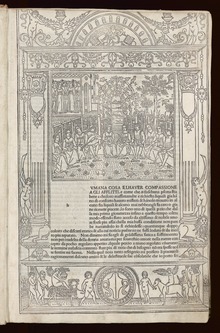Decamerone

Illustration from a ca. 1492 edition of Il Decameron published in Venice
|
|
| Author | Giovanni Boccaccio |
|---|---|
| Original title | Decamerone |
| Translator |
|
| Country | Italy |
| Language | Italian (Florentine) |
| Genre | Frame story, novellas |
| Publisher | Filippo and Bernardo Giunti |
|
Published in English
|
1886 |
| OCLC | 58887280 |
| 853.1 | |
| LC Class | PQ4267 |
The Decameron (Italian: Decameron [deˈkaːmeron; dekameˈrɔn; dekameˈron] or Decamerone [dekameˈroːne]), subtitled Prince Galehaut (Old Italian: Prencipe Galeotto [ˈprentʃipe ɡaleˈɔtto; ˈprɛntʃipe]), is a collection of novellas by the 14th-century Italian author Giovanni Boccaccio (1313–1375). The book is structured as a frame story containing 100 tales told by a group of seven young women and three young men sheltering in a secluded villa just outside Florence to escape the Black Death, which was afflicting the city. Boccaccio probably conceived the Decameron after the epidemic of 1348, and completed it by 1353. The various tales of love in The Decameron range from the erotic to the tragic. Tales of wit, practical jokes, and life lessons contribute to the mosaic. In addition to its literary value and widespread influence (for example on Chaucer's The Canterbury Tales), it provides a document of life at the time. Written in the vernacular of the Florentine language, it is considered a masterpiece of classical early Italian prose.
The book's primary title exemplifies Boccaccio's fondness for Greek philology: Decameron combines two Greek words, δέκα, déka ("ten") and ἡμέρα, hēméra ("day"), to form a term that means "ten-day [event]". Ten days is the period in which the characters of the frame story tell their tales.
...
Wikipedia
